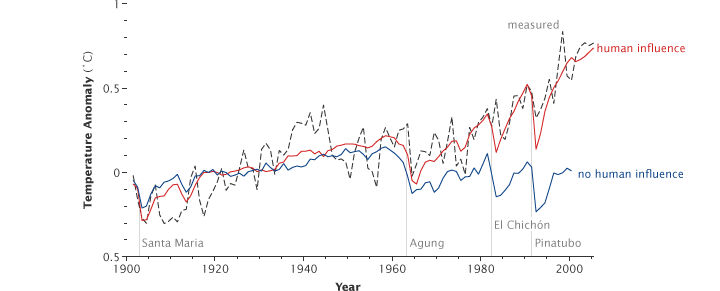Global warming
Contents |
If Earth has warmed and cooled throughout history, what makes scientists think that humans are causing global warming now?
The rate at which temperature is changing
The first piece of evidence that the warming over the past few decades isn’t part of a natural cycle is how fast the change is happening. The biggest temperature swings our planet has experienced in the past million years are the ice ages. Based on a combination of paleoclimate data and models, scientists estimate that when ice ages have ended in the past, it has taken about 5,000 years for the planet to warm between 4 and 7 degrees Celsius. In the past century alone, the temperature has climbed about 0.7 degrees Celsius, which is roughly eight times faster than previous warming.
No natural cause for temperature changes
The second reason that scientists think the current warming is not from natural influences is that, over the past century, scientists from all over the world have been collecting data on natural factors that influence climate—things like changes in the Sun’s brightness, major volcanic eruptions, and cycles such as El Niño and the Pacific Decadal Oscillation. These observations have failed to show any long-term changes that could fully account for the recent, rapid warming of Earth’s temperature.
Reconstructions of global temperature that include greenhouse gas increases and other human influences (red line, based on many models) closely match measured temperatures (dashed line). Those that only include natural influences (blue line, based on many models) show a slight cooling, which has not occurred. The ability of models to generate reasonable histories of global temperature is verified by their response to four 20th-century volcanic eruptions: each eruption caused brief cooling that appeared in observed as well as modeled records. (Graph adapted from Hegerl and Zwiers et al., 2007.)
Finally, scientists know that carbon dioxide is a greenhouse gas and that it is released into the air when coal and other fossil fuels burn. Paleoclimate data show that atmospheric carbon dioxide levels are higher than they have been in the past 800,000 years. There is no plausible explanation for why such high levels of carbon dioxide would not cause the planet to warm.
Air bubbles trapped in Antarctic ice preserve an 800,000-year record of atmospheric carbon dioxide levels, which naturally varied from about 180 to about 280 parts per million. Once humans began burning large quantities of coal and oil in the 19th century, concentrations rose to 315 parts per million by 1958 (when direct measurements of carbon dioxide in the Antarctic atmosphere began) to 380 parts per million in 2007. (NASA graph by Robert Simmon, based on data from Keeling et al., 2008.)
References
- Hegerl, G. C., Zwiers, F. W., Braconnot, P., Gillett, N. P., Luo, Y., Orsini, J. A., Nicholls, N., et al. (2007). Chapter 9: Understanding and attributing climate change. In Climate Change 2007: The Physical Science Basis. Contribution of Working Group I to the Fourth Assessment Report of the Intergovernmental Panel on Climate Change. [Solomon, S., Qin, D., Manning, M., Chen, Z., Marquis, M., Averyt, K.B. , Tignor, M., and Miller, H.L. (eds.)] Cambridge and New York: Cambridge University Press.
- Jansen, E., Overpeck, J., Briffa, K.R. , Duplessy, J.-C , Joos, F., Masson-Delmotte, V., Olgao, D., et al. (2007). Chapter 6: Paleoclimate. In Climate Change 2007: The Physical Science Basis. Contribution of Working Group I to the Fourth Assessment Report of the Intergovernmental Panel on Climate Change. [Solomon, S., Qin, D., Manning, M., Chen, Z., Marquis, M., Averyt, K.B. , Tignor, M., and Miller, H.L. (eds.)] Cambridge and New York: Cambridge University Press.
- Lean, J. L., & Rind, D. H. (2008). How natural and anthropogenic influences alter global and regional surface temperatures: 1889 to 2006. Geophysical Research Letters, 35(18).
- Lockwood, M., & Fröhlich, C. (2008). Recent oppositely directed trends in solar climate forcings and the global mean surface air temperature. II. Different reconstructions of the total solar irradiance variation and dependence on response time scale. Proceedings of the Royal Society A: Mathematical, Physical and Engineering Sciences, 464(2094), 1367-1385.
- Lüthi, D., Le Floch, M., Bereiter, B., Blunier, T., Barnola, J., Siegenthaler, U., Raynaud, D., et al. (2008). High-resolution carbon dioxide concentration record 650,000–800,000 years before present. Nature, 453(7193), 379-382. [Download 800,000-Year CO2 Data]
- Steele, L. P., Krummel, P. B., & Langenfelds, R. L. (2007). Atmospheric CO2 concentrations from sites in the CSIRO Atmospheric Research GASLAB air sampling network (August 2007 version). In Trends: A Compendium of Data on Global Change, Carbon Dioxide Information Analysis Center, Oak Ridge National Laboratory, US Department of Energy, Oak Ridge, TN, USA.
- Source: NASA web site, Rebecca Lindsey, May 4, 2010http://earthobservatory.nasa.gov/blogs/climateqa/if-earth-has-warmed-and-cooled-throughout-history-what-makes-scientists-think-that-humans-are-causing-global-warming-now/" rel="nofollow" title="Source">[ref]
This site costs a lot of money in bandwidth and resources. We are glad to bring it to you free, but would you consider helping support our site by making a donation? Any amount would go a long way towards helping us continue to provide this useful service to the community.
Click on the Paypal button below to donate. Your support is most appreciated! |
|---|




